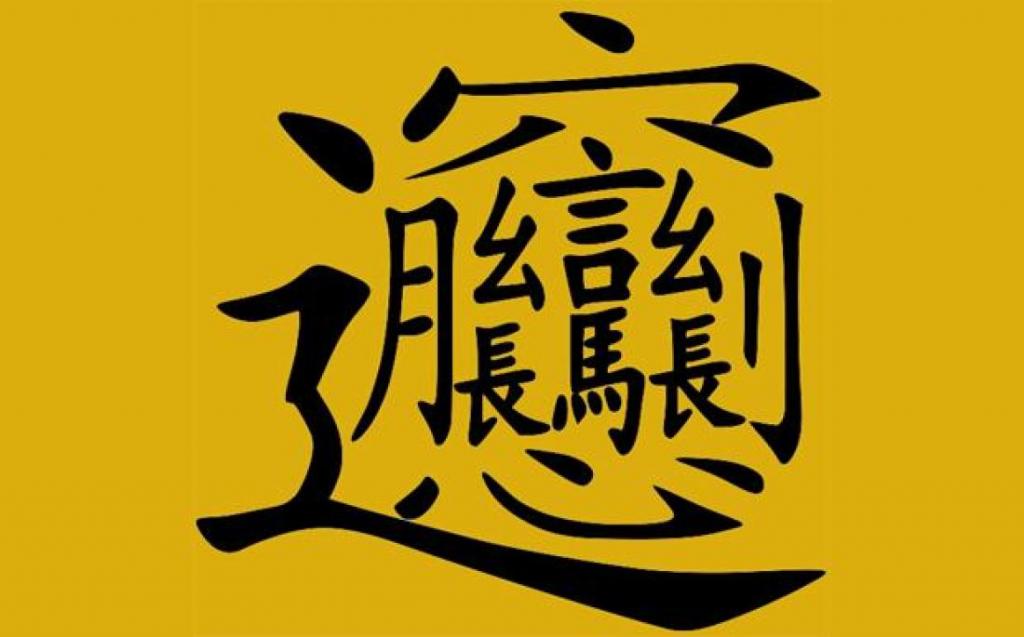"Chinese letter" - with these words a Russian person, without hesitation, will designate something difficult to understand. Chinese characters are indeed sometimes frightening with their intricate appearance. Which of the characters in the script of the Celestial Empire are the most complex?
What is the most difficult character?
This question worries many - both foreigners studying the Chinese language, and the Chinese themselves.
In 2006, the National Academy of Chinese Language published information about the character with the most features. The symbol, awarded the official title of the most complex character in the Chinese language, consists of two repeating elements "dragon" and means "flight of the dragon." There are 32 features in total.
For the first on the list of the most complex Chinese characters, the symbol may seem rather straightforward. And in fact, not everyone agrees with the above point of view of the academy.
But is it even more complicated?
Real living language is always more diverse than the conventional norm defined by scientists. In the media you can find references to the fact that the most complex Chinese character has 57 features. Such a hieroglyph really exists, although it is not fixed in dictionaries and does not have its own symbol in Unicode. It denotes a variety of noodles represented in the cuisine of one of the northern provinces - Shanxi. The hieroglyph "bian" is read, with ascending intonation - such a syllable does not exist in standard Chinese. Folk fantasy offers interesting interpretations of the origin of the name of the dish. According to one version, “bian” depicts the sound with which the dough for future noodles flops onto the table when it is stretched. A beautiful hieroglyph allegedly came up with a noodle-friendly master calligraphy student who had nothing to pay for lunch. Be that as it may, the fact remains that ordinary peasant noodles gained popularity both among Chinese and among foreigners thanks to an intricate name.

One of the most complex Chinese characters includes elements such as "go," "hole / cave," "words, speech," "grow," "horse," "eight," "heart," "moon," and " knife. " There are even songs in Chinese that combine all these words in a semblance of history just to remember how the name of the dish is spelled.
Besides banyan noodles, there are some more curious applicants for entering the list of the most complex Chinese characters.
The hieroglyph "nan" (pronounced with a descending intonation) means nasal congestion. The left side means “nose” (鼻), the right one means “close” (囊). A total of 36 traits.
And a few more dragons
A hieroglyph is sometimes used to indicate a dragon’s flight, in which this element is repeated three times. It has only 48 features. True, the Chinese Language Academy mentioned above considered that the third dragon does not have a special semantic load, which means that it cannot be accounted for.
But in one of the newest editions of the explanatory dictionary of the Chinese language appeared a hieroglyph consisting of four elements "dragon" - a total of 68 features. Only now its significance does not have the slightest relation to mythical creatures. It can be translated into Russian as "being verbose" or "chatting incessantly."
A bit of japanese
Acquainted with the noodles from "horses, words, hearts, the moon" and others like them, stuffed noses and numerous dragons, you can come to the conclusion that Chinese characters are the most complex in the world.
But still, the character with the most features was invented not by the Chinese, but by the Japanese. In it above the four “dragons” there are three more elements with the meaning of “cloud” - a total of 84 features. True, this is a proper name: over the past century, a hieroglyph with reading options “taito”, “daito” and “otodo” has appeared several times in Japanese dictionaries of rare names.
And at the beginning of our century, it was used several times in the names of restaurants selling ... noodles. True, it is no longer Chinese, but Japanese.